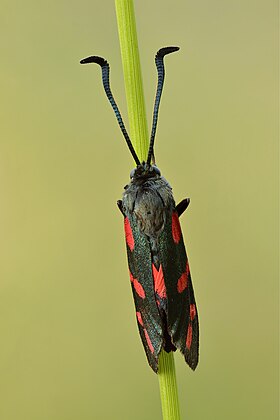Talk:Six-spot burnet
| This article is rated Start-class on Wikipedia's content assessment scale. It is of interest to the following WikiProjects: | |||||||||||||||||||||
| |||||||||||||||||||||
Gallery pruned and reinstated
[edit]I've pruned and reinstated the gallery, after it was removed by another editor.
I don't work on many entomology pages, but on the botany and mineral-species pages I frequent, a gallery can be both useful and encyclopedic -- so long as it doesn't get overgrown, as this one had. This page was weaker without a gallery, I think. Thanks, Pete Tillman (talk) 21:00, 21 September 2010 (UTC)
- The critical factor is whether the images are illustrating anything. An uncurated collection of images is not particularly useful. I have replaced it with a box displaying the life cycle, which ties in to the text and clearly illustrates the different stages, in order (although there are no pictures of the egg available, unfortunately). --Stemonitis (talk) 07:38, 29 September 2010 (UTC)
- Good work -- thanks. As you say, better-integrated now. Best, Pete Tillman (talk) 05:40, 12 October 2010 (UTC)
Featured picture scheduled for POTD
[edit]Hello! This is to let editors know that File:Zygaena filipendulae_(top_view)_-_Kulna.jpg, a featured picture used in this article, has been selected as the English Wikipedia's picture of the day (POTD) for June 19, 2024. A preview of the POTD is displayed below and can be edited at Template:POTD/2024-06-19. For the greater benefit of readers, any potential improvements or maintenance that could benefit the quality of this article should be done before its scheduled appearance on the Main Page. If you have any concerns, please place a message at Wikipedia talk:Picture of the day. Thank you! — Amakuru (talk) 10:35, 12 June 2024 (UTC)

|
The six-spot burnet (Zygaena filipendulae) is a moth of the family Zygaenidae. It is a common species throughout Europe, except the Atlantic coast of the Iberian Peninsula, northern Scandinavia and the Great Russian North, and is also present in Asia Minor, through the Caucasus to Syria and Lebanon. It inhabits meadows, woodland clearings, sea-cliffs and area rich in grasses and flowers, up to 2,000 m altitude. The adults fly on hot, sunny days and are attracted to a wide variety of flowers such as knapweed and scabious, as well as the larval food plants bird's foot trefoil, Dorycnium, Coronilla and clover. This six-spot burnet was photographed in Kulna, Estonia. Photograph credit: Ivar Leidus
Recently featured:
|
